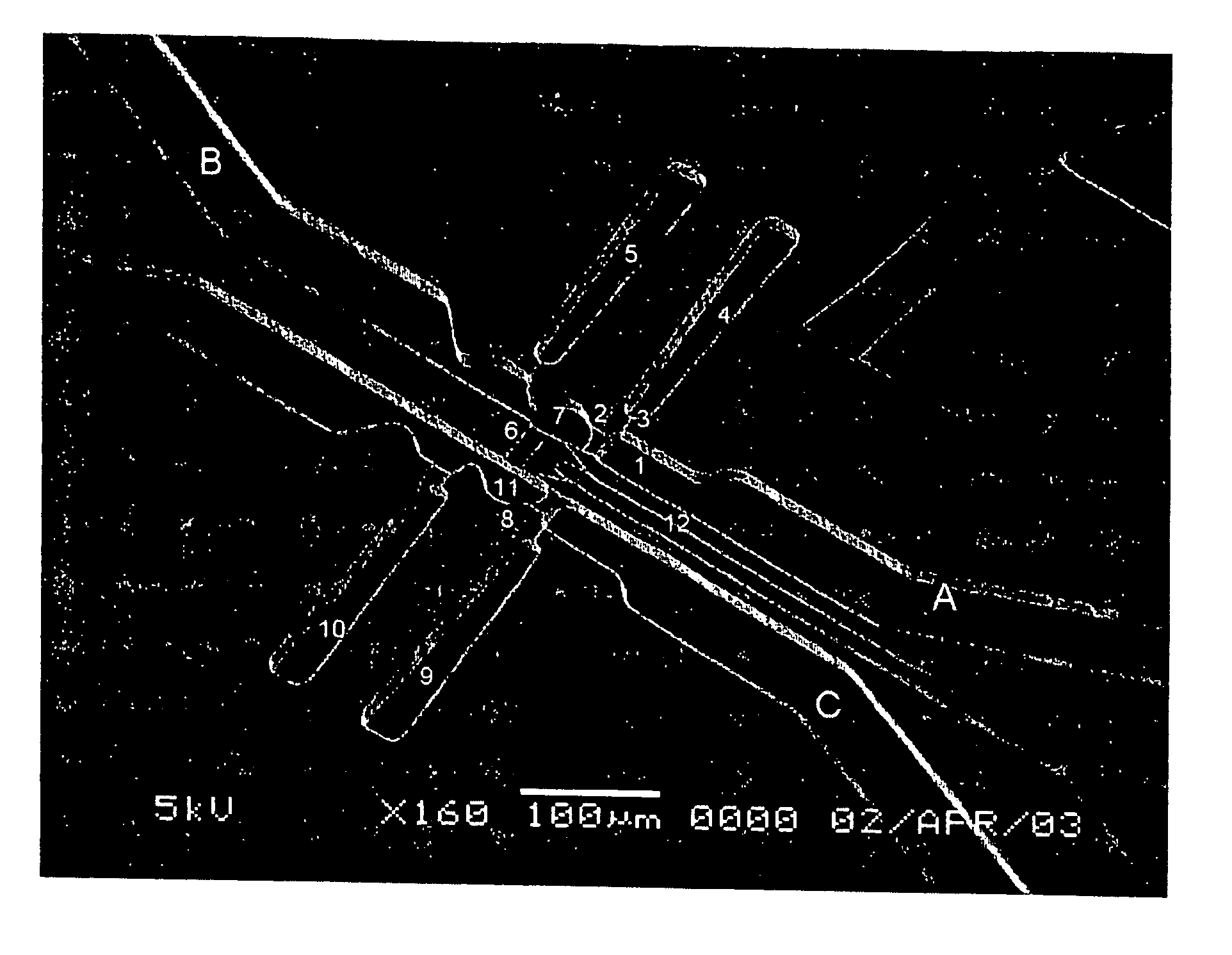Device and method for contacting picoliter volumes of fluid
a fluid and picoliter technology, applied in the field of microfluidics and cellular assays, can solve the problems of cell lysis, inability to achieve control mixing of two solutions in volumes, and extraction of average information from populations
- Summary
- Abstract
- Description
- Claims
- Application Information
AI Technical Summary
Benefits of technology
Problems solved by technology
Method used
Image
Examples
example 1
Fabrication of a Picoliter Mixing Device of the Invention
[0072] A device of the invention was microfabricated using standard techniques. Channels were patterned in PDMS by casting the polymer on a mold of SU-8 photoresist photopatterned on glass. Three different layers of SU-8 were patterened on the same substrate in order to create structures with different heights that correspond to channels of different cross sectional dimensions in the PDMS slab. Micro-heaters were fabricated by patterning gold electrodes on glass. The PDMS slab and the glass with the electrodes were aligned and bonded using oxygen plasma. The surfaces of the channels (both the PDMS and the glass) were modified using fluorosilane and rendered hydrophobic. The assembled device contains a series of channels with different widths and heights as shown in FIG. 1, and in more detail in FIG. 2.
[0073] The dimensions of the device were as follows: channel 1: 30×85×15 μm (w×1×h); constrictions 2 and 8: 12.5×12.5×4 μm; c...
example 2
Lysis of a Cell Using a Picoliter Mixing Device of the Invention
[0074] Referring to FIGS. 1 and 2, an isotonic phosphate buffer solution (PBS) was introduced through inlet A. By applying moderate pressure (˜20 kPa), the PBS was pushed through channel 1, and the fluid was stopped at constriction 2. The fluid also did not enter channel 3, and, as a consequence, air was trapped in chamber 4. A cell suspension of 3T3 mouse fibroblast or MOLT-T lymphoblasts was introduced through inlet B. The liquid column joined the PBS column while air was trapped in chamber 5. The liquid would not pass through channel 6 unless too high a pressure was applied (˜80 kPa). While fluid could flow through constriction 2, cells larger than the constriction were trapped in chamber 7. Similarly, the lysing solution (3 M guanidine thiocyanate in water) was introduced through inlet C and pushed through constriction 8, trapping air in chambers 9 and 10. When the desired number of cells (one or more) was trapped ...
example 3
Exemplary Picoliter Mixing Device
[0075] In one exemplary device, cells and fluids are independently isolated in two microchambers having 25 pL volumes, through the coordinated action of four on-chip thermopneumatic actuators and using the hysteresis in the liquid-solid contact angles. The two volumes are initially separated by virtual walls formed by liquid-air interfaces in the hydrophobic capillary connecting the two microchambers, and then mixed by drawing the air out of the capillary. The use of the microfabricated device is exemplified on two assays at the single cell level, one for estimating intracellular concentration of a preloaded fluorescent dye, and one for evaluating intracellular amount of insoluble, filamentous actin.
[0076] Principles of Device Design. Precise manipulation of liquids, air, and cells inside the device is achieved through passive and active control structures. As shown in the schematics in FIGS. 3A-3D, the device consists of a network of hydrophobic c...
PUM
| Property | Measurement | Unit |
|---|---|---|
| contact angle | aaaaa | aaaaa |
| concentration | aaaaa | aaaaa |
| volume | aaaaa | aaaaa |
Abstract
Description
Claims
Application Information
 Login to View More
Login to View More - R&D
- Intellectual Property
- Life Sciences
- Materials
- Tech Scout
- Unparalleled Data Quality
- Higher Quality Content
- 60% Fewer Hallucinations
Browse by: Latest US Patents, China's latest patents, Technical Efficacy Thesaurus, Application Domain, Technology Topic, Popular Technical Reports.
© 2025 PatSnap. All rights reserved.Legal|Privacy policy|Modern Slavery Act Transparency Statement|Sitemap|About US| Contact US: help@patsnap.com



